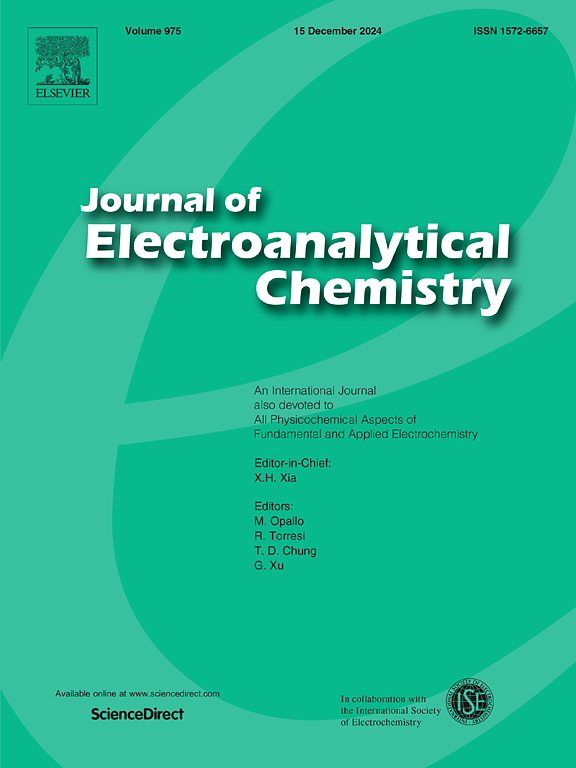对乙酰氨基酚和酪氨酸在粘土/活性炭复合膜修饰玻碳电极上的电化学行为及定量研究
IF 4.1
3区 化学
Q1 CHEMISTRY, ANALYTICAL
引用次数: 0
摘要
采用分批法获得了一种由 2.5% 的介孔碳和 97.5% 的喀麦隆天然粘土制成的复合材料(即 Sa-AC)。XRD 分析表明,尽管粘土片之间的层间空间略有减少,但复合材料中的粘土仍保持了层状结构。与原始粘土(90 m2/g)相比,获得的复合材料具有较大的表面积(约 111 m2/g)和较高的孔隙率,这使得被命名为 Sa-AC/GCE 的复合薄膜改性玻璃碳电极(GCE)具有较大的活性表面积和较快的电子传输速率。与裸电极和粘土修饰电极相比,复合膜修饰的 GCE (i) 通过 EC 机制对对乙酰氨基酚(Acet)和酪氨酸(Tyr)具有良好的电催化活性,(ii) Acet 的电氧化可逆性不受 Tyr 不可逆氧化的影响。在最佳条件下,使用线性扫频伏安法,复合薄膜电极可同时定量分析 Acet 和 Tyr,Acet 的定量范围为 0.2 μM 至 90 μM,Tyr 的定量范围为 0.2 μM 至 32 μM,LOD 分别为 0.19 μM 和 0.23 μM(S/N = 3);LOQ 分别为 0.77 μM 和 2.05 μM(LOD = 10 S/M)。据估计,Sa-AC/GCE 对 Acet 的灵敏度为 0.022 μA/μM,对 Tyr 的灵敏度为 0.017 μA/μM。此外,Sa-AC/GCE 还成功地定量检测了药物中的乙酸和自来水中的酪氨酸,片剂的回收率范围为 91.30% 至 109.44%,片剂水的回收率范围为 102.47%。本文章由计算机程序翻译,如有差异,请以英文原文为准。

Electrochemical behavior and quantification of acetaminophen and tyrosine at clay/activated carbon composite film modified glassy carbon electrode
A composite (namely Sa-AC) made of 2.5 % of mesoporous carbon and 97.5 % of natural Cameroonian clay was obtained using batch method. As revealed by XRD analysis, the clay within the composite retains its layer structure despite a slight decrease of interlayer space between clay sheets. The as-obtained composite has larger surface area (ca 111 m2/g) and high pore volume compared to the pristine clay (90 m2/g), which endowed the composite film modified glassy carbon electrode (GCE), designated as Sa-AC/GCE, with a large active surface area and fast electron transfer rate. In contrast to the bare and clay modified electrodes, the composite film modified GCE has (i) good electrocatalytic activity toward acetaminophen (Acet) and Tyrosine (Tyr) via an EC mechanism, and (ii) the reversibility of the electrooxidation of Acet was not affected by the irreversible oxidation of Tyr. Under optimal conditions, and using linear sweep voltammetry, the composite film electrodes were used to simultaneously quantify Acet and Tyr in the range of 0.2 μM to 90 μM for Acet and 0.2 μM to 32 μM for Tyr with LOD of 0.19 μM and 0.23 μM (S/N = 3); LOQ of 0.77 μM and 2.05 μM (LOD = 10 S/M), respectively. The sensitivity of Sa-AC/GCE was estimated to be 0.022 μA/μM for Acet and 0.017 μA/μM for Tyr. In addition, the Sa-AC/GCEs were successful for the quantification of Acet in pharmaceutical medicine and Tyr in a tap water with a good recovery range from 91.30 to 109.44 % for the tablets and 102.47 % for tab water.
求助全文
通过发布文献求助,成功后即可免费获取论文全文。
去求助
来源期刊
CiteScore
7.80
自引率
6.70%
发文量
912
审稿时长
2.4 months
期刊介绍:
The Journal of Electroanalytical Chemistry is the foremost international journal devoted to the interdisciplinary subject of electrochemistry in all its aspects, theoretical as well as applied.
Electrochemistry is a wide ranging area that is in a state of continuous evolution. Rather than compiling a long list of topics covered by the Journal, the editors would like to draw particular attention to the key issues of novelty, topicality and quality. Papers should present new and interesting electrochemical science in a way that is accessible to the reader. The presentation and discussion should be at a level that is consistent with the international status of the Journal. Reports describing the application of well-established techniques to problems that are essentially technical will not be accepted. Similarly, papers that report observations but fail to provide adequate interpretation will be rejected by the Editors. Papers dealing with technical electrochemistry should be submitted to other specialist journals unless the authors can show that their work provides substantially new insights into electrochemical processes.

 求助内容:
求助内容: 应助结果提醒方式:
应助结果提醒方式:


